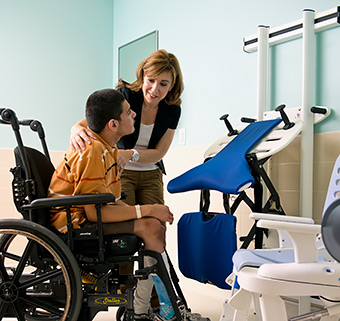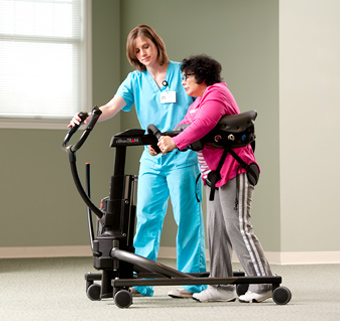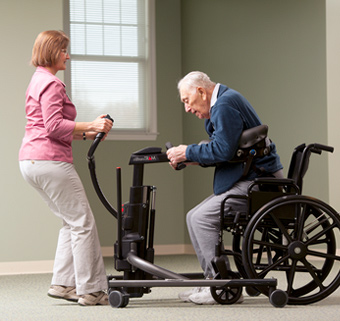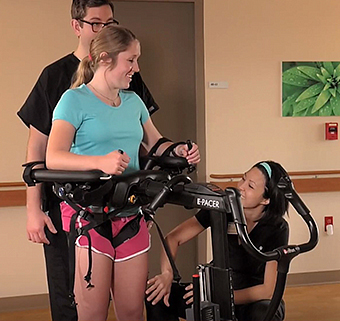Improving Rehabilitation Prospects with the E-Pacer
| September 2019


Individuals hospitalized due to stroke or brain injury have one over-arching goal: to return home and into the community again. Unfortunately, many individuals with lasting debility require placement in long-term care or assisted living instead. This isolation and loss of independence can be devastating to patients and families. Because independent walking is a primary predictor of whether a patient can safely return home, it’s not surprising that patients work hard to achieve improved mobility in their inpatient therapy sessions.1-6 Despite these efforts, those that do go home still experience difficulty walking that affects independence and quality of life.6-10
Recent assimilation of research, motor learning theory, and technology into rehabilitation is rapidly improving the prospects of those going home, with notable improvements in mobility outcomes.
Motor Learning and Unweighted Gait Intervention
Body weight support gait training, whether on a treadmill or over-ground, provides an optimal environment for motor learning, as it is intensive, repetitive and task-specific.11-13 Solid evidence describes such interventions helping patients achieve increased gait speed, symmetry, trunk control, balance and upright posture.2,3,6,7,9,10,12,14-17
Traditional therapy focuses on regaining trunk control and sitting balance before standing and gait. When gait training begins, it is in parallel bars or with a walker. Knee buckling, foot drag, and fatigue can make a patient fearful of falling. The therapist also cannot facilitate proper leg movement because they are guarding the patient. Because of these issues, distance is limited. In body-weight support systems, however, patients are up and walking earlier with less cardiac demand and fatigue, thus gaining additional practice time and higher step repetitions.9,12,13,18 In the first 14 days post stroke, patients who were upright and walking for 10 minutes at least twice a day, demonstrated higher rates of return to independent walking and shorter rehabilitation stays compared to controls receiving standard stroke care.5 Further, patients who performed unweighted ambulation walked with a higher quality gait pattern and developed less compensatory gait deviations.1,2,9,14,15,17 This means they demonstrated increased hip extension and strength, decreased hip flexor patterning and foot drop: common problems associated with the functional deficits and gait deviations noted in patients who went home after conventional therapy interventions.1,6,14,10,16
Gait Technology – the Pros and Cons
Unweighted gait training devices frequently utilized in rehab facilities range from body weight supported treadmills (Biodex) to robotic devices (Lokomat) and ceiling harnesses (Zero-G). These provide the necessary unweighting and support features to meet ambulation and motor learning goals. However, because of the complexity of these larger devices, therapists must undergo extensive training and practice in order to use them safely and effectively with a patient.19 Newer staff or resource staff members may not have the experience to follow the plan of care.
With rising healthcare costs and decreased insurance reimbursement, many rehabilitation facilities are unable to afford these systems, which can cost between $30,000 and $200,000. Robotic systems and ceiling tracks are the most expensive, often prohibitively so. With ceiling track systems, it is also difficult for a therapist to move with the patient as they advance down the track, making it a challenge to facilitate movement of the weaker limb. While somewhat more affordable, treadmill gait training does not allow a patient to practice turning, a necessary intervention for fall prevention and gait recovery.13,21 Body weight support treadmill training is also physically taxing for a therapist, and can cause fatigue, muscle soreness or work-related repetitive injury to the therapists themselves.20 Set-up and take-down time on a relatively dependent patient can significantly cut into the actual time that a patient is up and walking.
This is why over-ground gait devices are catching attention in rehab facilities across the county.
Revolutionizing Gait Rehab with the E-Pacer
The E-Pacer, a supportive over-ground walking device, takes gait intervention a step further, allowing clinicians to better meet the recommendations in the literature. With a lightweight frame, easily adjustable supports and electric sit-to-stand assistance, set-up is a snap. Patients are up and walking quickly and safely, giving more time in practice and more step repetitions. Studies done with BWSTT recommend a patient should ambulate over 1,000 steps in 20 minutes to improve outcomes.1 In the E-Pacer, because set-up is quick and simple, a patient can easily cover 1,500 steps in a session.
The E-Pacer wheels, designed specifically for ambulation, allow the patient to walk anywhere in the facility. It allows the patient to speed up as they progress or slow down as they fatigue. This includes the option to side step, step backwards, turn or practice dynamic functional reaching. With the E-Pacer in the posterior position, further intensity and variability can be included in the gait training session. Patients prefer the Rifton E-Pacer for its comfort and control of pace and stepping.
Therapists appreciate the ease of use and capacity to have their patients walking greater distances and making rapid improvements in gait recovery so they can return home quickly and with good functional abilities. A therapist sitting on a rolling stool, with their feet resting on the frame of the E-Pacer, is in an ideal ergonomic position to help the patient to advance their weaker limb, facilitating dorsiflexion, hip flexion, and knee extension to overcome drop-foot and knee buckling.
Because the Rifton E-Pacer can be purchased for under $6,000.00, it makes unweighted gait training affordable for many facilities that may not have the budget for a more expensive device. This ensures appropriate access to care, keeps practice current and evidence-based, and helps facilities best serve their adult neuro populations with state-of-the-art, competitive treatment options.
References
- Mao YR, Lo WL, Lin Q, Li L, Xiao X et al. The effects of body weight support treadmill training on gait recovery, proximal lower limb motor patter, and balance in patients with subacute stroke. Biomed Res Int. 2015:175719. https://doi.org/10.1155/2015/175719
- Ng MF, Tong RK, Li LS. A pilot study of randomized clinical controlled trial of gait training in subacute stroke patients with partial body-weight support electromechanical gait trainer and functional electrical stimulation: six-month follow-up. Stroke. 2008;39 (1):154-60. https://doi.org/10.1161/STROKEAHA.107.495705
- Prado-Medeiros CL, Sousa CO, Souza AS, Soares MR, Barela AM, et al. Effects of the addition of functional electrical stimulation to ground level gait training with body weight support after chronic stroke. Rev Bras Fisioter. 2011;15(6):436-44. http://dx.doi.org/10.1590/S1413-35552011005000030
- Srivastava A, Taly AB, Gupta A, Kumar S, Murali T. Bodyweight-supported treadmill training for retraining gait among chronic stroke survivors: A randomized controlled study. Ann Phys Rehabil Med. 2016;59(4):235-41. https://doi.org/10.1016/j.rehab.2016.01.014
- Cumming TB, Thrift AG, Collier JM. Very early mobilization after stroke fast-tracks return to walking. Further results from the phase II AVERT randomized controlled trial. Stroke. 2011;(42):153-58 https://www.ahajournals.org/doi/pdf/10.1161/STROKEAHA.110.594598
- Park BS, Kim MY, Lee LK, Yang SM, Lee WD, et al. Effects of conventional overground gait training and a gait trainer with partial body weight support on spatiotemporal gait parameters of patients after stroke. J Phys Ther Sci. 2015;27(5):1603-7. https://doi.org/10.1589/jpts.27.1603
- Chen G, Patten C. Treadmill training with harness support: selection of parameters for individuals with poststroke hemiparesis. J Rehabil Res Dev. 2006;43(4): 485-97. https://www.rehab.research.va.gov/jour/06/43/4/pdf/Chen.pdf
- Drużbicki M, Przysada G, Guzik A, Brzozowska-Magoń A, Kołodziej K, et al. The efficacy of gait training using a body weight support treadmill and visual biofeedback in patients with subacute stroke: A randomized controlled trial. Biomed Res Int. 2018;Apr 5. Article ID 3812602. https://doi.org/10.1155/2018/3812602
- McCain KJ, Pollo FE, Baum BS, Coleman SC, Baker S, et al. Locomotor treadmill training with partial body-weight support before overground gait in adults with acute stroke: a pilot study. Arch Phys Med Rehabil. 2008;89(4):684-91. https://doi.org/10.1016/j.apmr.2007.09.050
- Song GB, Ryu, HJ. Effects of gait training with rhythmic auditory stimulation on gait ability in stroke patients. J Phys Ther Sci. 2016;28(5):1403-6. https://doi.org/10.1589/jpts.28.1403
- Lindquist AR, Prado CL, Barros RL, Mattioli R, da Costa PL, et al. Gait training combining partial body-weight support, a treadmill, and functional electrical stimulation: effects on poststroke gait. Phys Ther. 2007;87(9), 1144-54. https://doi.org/10.2522/ptj.20050384
- Sullivan KJ, Knowlton BJ, Dobkin BH. Step training with body weight support: effect of treadmill speed and practice paradigms on poststroke locomotor recovery. Arch Phys Med Rehabil. 2002;83(5): 683-91. https://doi.org/10.1053/apmr.2002.32488
- Hornby GT, Holleran CL, Hennessy PW, et. al. Variable intensive early walking poststroke (VIEWS): A randomized controlled trial. Neurorehabil Neural Repair. 2016;30(5):440-50. https://journals.sagepub.com/doi/pdf/10.1177/1545968315604396
- Mulroy SJ, Klassen T, Gronley JK, Eberly VJ, Brown DA, et al. Gait parameters associated with responsiveness to treadmill training with body-weight support after stroke: an exploratory study. Phys Ther. 2010;90(2):209-23. https://doi.org/10.2522/ptj.20090141
- Ullah MA, Shafi H, Khan GA, Malik AN, Amjad IJ. The effects of gait training with body weight support (BWS) with no body weight support (no-BWS) in stroke patients. Pak Med Assoc. 2017;67(7):1094-1096. http://jpma.org.pk/full_article_text.php?article_id=8285
- Iosa M, Morone G, Bragoni M, De Angelis D, Venturiero V, et al. Driving electromechanically assisted Gait Trainer for people with stroke. J Rehabil Res Dev. 2011;48(2):135-46. https://www.rehab.research.va.gov/jour/11/482/pdf/page135.pdf
- Tyrell CM, Roos MA. Rudolph KS, Reisman DS. Influence of systematic increases in treadmill walking speed on gait kinematics after stroke. Phys Ther. (91)3:392-403.
- Delussu AS, Morone G, Iosa M, Bragoni M, Traballesi M, et al. Physiological responses and energy cost of walking on the Gait Trainer with and without body weight support in subacute stroke patients. J Neuroeng Rehabil. 2014;Apr 10;11:54. https://doi.org/10.1186/1743-0003-11-54
- Dobkin BH. An overview of treadmill locomotor training with partial body weight support: a neurophysiologically sound approach whose time has come for randomized clinical trials. Neurorehabil Neural Repair. 1999;13(3): 157-165. https://doi.org/10.1177/154596839901300301
- Werner C, von Frankenberg S, Treig T, et al. Treadmill training with partial body weight support and an electromechanical gait trainer for restoration of gait in subacute stroke pateints. Stroke. 2002;(2) 2895-901.
- Chen IH, Yang YR, Chan RC, Wang RY. Turning-based treadmill training improves turning performance and gait symmetry after stroke. Neurorehabil Neural Repair. 2014;28(1):45-55. https://doi.org/10.1177/1545968313497102





